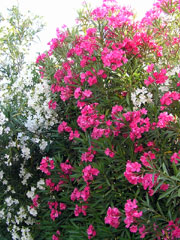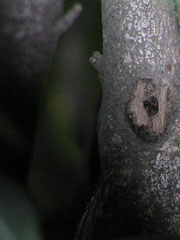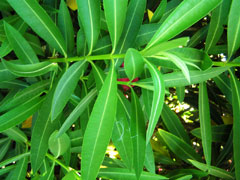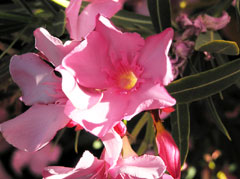Oleander
Scientific name: Nerium OleanderFamily: Apocynaceae
Podcast Script
 Whole Plant |
 Bark |
 Leaves |
 Flower |
Classification:
Angiosperm, Dicot, evergreenSize:
.At maturity, an oleander plant can reach up to 12 feet in height, while they can be also found with sizes of 2 to 6 meters. The leaves can be 10 to 22 centimeters long and around 2.5 centimeters wide. The fruit consists of a capsule that's 10 to 12 centimeters long while its width is 6 to 8 mm in diameter, and the flowers are around 2.5 to 5 centimeters in diameter.Identifying Features:
.The oleander looks like a small tree or evergreen shrub and contains lots of pink and white flowers. There is green foliage and the leaves have a notable midrib. The flowers could be bright red, pink, white, purple, and lilac, and they have very long petals. Near summer, the brown fruits of the oleander are visible as it continues to grow throughout the beginning of fall. The bark of the oleander is either grayish or greenish gray in color.Location/Habitat:
.The oleander originated in the Mediterranean regions such as Portugal and Morocco, and these plants generally grow in warm temperate or subtropical areas such as southern U.S., but they are present worldwide. Oleander plants are grown in parks and can be found near roads and watercourses, though they are planted in pots or grown in conservatories. Lastly, they are very drought tolerant since they can grow near highways.Flower/Fruit/Reproduction:
.The flowers of the oleander have multifarious colors that range from red to white to purple. The fruit itself has a brownish color, and it is basically a long seed pod with seeds (consists of tuft of brown hairs) inside of it. When the pods open, wind pollination becomes the form of reproduction for this plant. The fruits and seeds are generally available throughout summer and fall.Water/Sun Requirements:
.The oleander plant can survive sunny conditions as well as full sun conditions, which means it receives 6 or more hours of direct sunlight a day. The water range for the oleander is semi-arid to moist, which means it can survive drought-like conditions but it would produce less flowers. The plant might also benefit from moist conditions since there would be less water loss due to transpiration, but in most cases, it thrives without lots of water. For the plants grown at home, it is recommended that the oleanders receive 1 to 2 inches of water a week to promote faster growth. Generally, these plants grow naturally in the environment and don't need much water.Special Adaptations:
.The leaves, flowers, sap, and the entire body of the oleander plant contain toxins such as oleandrin and neriine, which could lead to death due to troubles in the heart and gastrointestinal tract. Butterflies that suck the nectar of the oleander can actually store the toxins in specialized cells, so when birds eat them, the birds get seriously ill and never try to eat these butterflies again. Basically, the toxins of the oleander plant prevents other animals from ingesting it, or else they will face life-threatening conditions.Other Info:
.Other names for the oleander include Laurel Rose, Rose Bay, and Rose of France..Oleander thrives everywhere, such as near ancient ruins, cliffs, riverbeds, big cities, etc.
.The toxic quality of the oleander was also found during Alexander the Great's period of time. In fact, several of Alexander's horses died due to drinking water poisoned with oleander by opposing, retreating forces.
."A species of grasshopper that inhabits the Middle Eastern countries also stores oleander nectar in its cells, which it sprays at its enemies in time of danger" (Source).
.Ingesting a single oleander leaf for infants is deadly, while over 20 leaves may be eaten by adults before causing adverse reactions
.The central nervous system could also be affected by the toxins, and symptoms include seizures, tremors, and even coma.
.Used properly, the oleander could also be used as medicine. The people of Mesopotamia back in the 15th century B.C. created their own folk remedies, and in 1966, Doctor Ozel of Turkey patented Anvirzel, which is a remedy made from Oleander extracts that could fight Hepatitis C, HIV, and also cancer since it stimulates the immune system.
.If you burn an oleander plant and breathe in the smoke, it would also cause damage to your respiratory system, though probably not death as many legends say.
.Oleanders like to grow in soil between a pH of 5.0 and 8.3.
."Oleander plants can be easily propagated by means of tip cuttings. Cuttings root easily when taken in early summer. The use of rooting hormones increases root production of the cuttings. Air layers can also be used to propagate this plant. Seeds are less frequently used for propagation" (Source).
Reference Sources/Links:
.http://www.vth.colostate.edu/poisonous_plants/report/report_detail_1.cfm?ID=334.http://www.gardenguides.com/plants/plant.asp?symbol=NEOL
.http://www.inchem.org/documents/pims/plant/pim366.htm
.http://www.backyardgardener.com/plantname/pda_5934.html
.http://www.thy.com/en-INT/corporate/skylife/article.aspx?mkl=102
.http://www.webindia123.com/garden/flowers/oleander.htm
.http://www.vet.purdue.edu/depts/addl/toxic/plant52.htm
.http://www.seminolecountyfl.gov/lls/coopext/articles.asp?articleID=519
.http://www.snopes.com/horrors/poison/oleander.asp
.http://www.henriettesherbal.com/eclectic/kings/nerium-olea.html
Created by Cheng Z. 2007